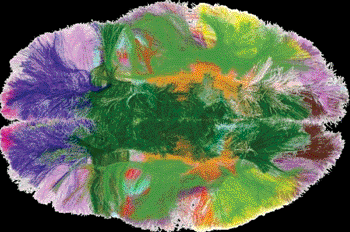First Microstructure Atlas of the Human Brain Revealed
By LabMedica International staff writers
Posted on 20 Nov 2012
The first complete atlas of the white-matter microstructure of the human brain has the potential to change the face of neuroscience and medicine over the coming decade. Posted on 20 Nov 2012
The new atlas, developed by leading research centers--in countries across Europe including Israel, United Kingdom, Germany, France, Denmark, Switzerland, and Italy--participating in the Consortium Of Neuroimagers for the Noninvasive Exploration of Brain Connectivity and Tracts (CONNECT; Paris, France) project, combines three-dimensional (3D) images from the magnetic resonance imaging (MRI) scans of the brains of 100 volunteers. To achieve this, CONNECT developed advanced MRI methods providing unprecedented detail and accuracy.

Image: Rendering of long white matter fiber bundles (Photo courtesy of CONNECT Consortium).
The new atlas simulates the painstaking task of examining every square millimeter of brain tissue (of which there are around 100 million per brain) with a microscope, while leaving the brain intact. The key novelty in the atlas is the mapping of microscopic features (such as average cell size and packing density) within the white matter, which contains the neuronal fibers that transmit information around the living brain. The atlas describes the brain's microstructure in standardized space, which enables nonexpert users, such as physicians or medical researchers, to exploit its knowledge.
The atlas also contains a variety of new images that represent different microscopic tissue characteristics, such as the fiber diameter and fiber density across the brain, all estimated using MRI. The images will serve as a reference standard for future brain studies in both medicine and basic neuroscience. Currently, biomedical research teams around the world studying brain science rely on a brain atlas produced by painstaking and destructive histological methods on the brains of a few individuals who donated their bodies to science.
“The UCL team uses the latest computer modeling algorithms and hardware to invent new imaging techniques. The techniques we devised were key to realizing the new CONNECT brain atlas,” said Prof. Daniel Alexander, PhD, a CONNECT steering committee member from the University College London (United Kingdom), department of computer science. “The imaging techniques reveal new information about brain structure that helps us understand how low-level cellular architecture relates to high-level thought processes.”
Historically in neuroscience, the vast majority of research effort has been invested in understanding and studying gray matter and neurons, while white matter has received relatively little attention, largely due to the lack of effective research tools to study white matter, even though it comprises about half the volume of the brain.
Related Links:
University College London
CONNECT














